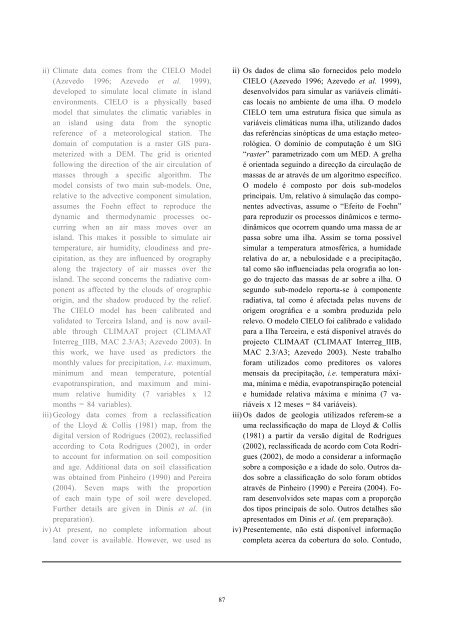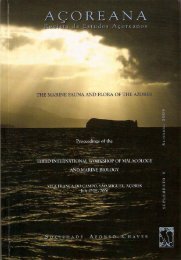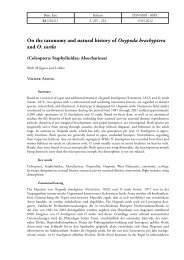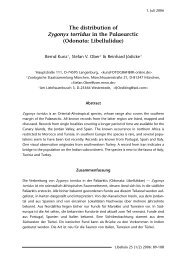(eds.) (2005). - Portal da Biodiversidade dos Açores - Universidade ...
(eds.) (2005). - Portal da Biodiversidade dos Açores - Universidade ...
(eds.) (2005). - Portal da Biodiversidade dos Açores - Universidade ...
Create successful ePaper yourself
Turn your PDF publications into a flip-book with our unique Google optimized e-Paper software.
ii) Climate <strong>da</strong>ta comes from the CIELO Model<br />
(Azevedo 1996; Azevedo et al. 1999),<br />
developed to simulate local climate in island<br />
environments. CIELO is a physically based<br />
model that simulates the climatic variables in<br />
an island using <strong>da</strong>ta from the synoptic<br />
reference of a meteorological station. The<br />
domain of computation is a raster GIS parameterized<br />
with a DEM. The grid is oriented<br />
following the direction of the air circulation of<br />
masses through a specific algorithm. The<br />
model consists of two main sub-models. One,<br />
relative to the advective component simulation,<br />
assumes the Foehn effect to reproduce the<br />
dynamic and thermodynamic processes occurring<br />
when an air mass moves over an<br />
island. This makes it possible to simulate air<br />
temperature, air humidity, cloudiness and precipitation,<br />
as they are influenced by orography<br />
along the trajectory of air masses over the<br />
island. The second concerns the radiative component<br />
as affected by the clouds of orographic<br />
origin, and the shadow produced by the relief.<br />
The CIELO model has been calibrated and<br />
vali<strong>da</strong>ted to Terceira Island, and is now available<br />
through CLIMAAT project (CLIMAAT<br />
Interreg_IIIB, MAC 2.3/A3; Azevedo 2003). In<br />
this work, we have used as predictors the<br />
monthly values for precipitation, i.e. maximum,<br />
minimum and mean temperature, potential<br />
evapotranspiration, and maximum and minimum<br />
relative humidity (7 variables x 12<br />
months = 84 variables).<br />
iii) Geology <strong>da</strong>ta comes from a reclassification<br />
of the Lloyd & Collis (1981) map, from the<br />
digital version of Rodrigues (2002), reclassified<br />
according to Cota Rodrigues (2002), in order<br />
to account for information on soil composition<br />
and age. Additional <strong>da</strong>ta on soil classification<br />
was obtained from Pinheiro (1990) and Pereira<br />
(2004). Seven maps with the proportion<br />
of each main type of soil were developed.<br />
Further details are given in Dinis et al. (in<br />
preparation).<br />
iv) At present, no complete information about<br />
land cover is available. However, we used as<br />
87<br />
ii) Os <strong>da</strong><strong>dos</strong> de clima são forneci<strong>dos</strong> pelo modelo<br />
CIELO (Azevedo 1996; Azevedo et al. 1999),<br />
desenvolvi<strong>dos</strong> para simular as variáveis climáticas<br />
locais no ambiente de uma ilha. O modelo<br />
CIELO tem uma estrutura física que simula as<br />
variáveis climáticas numa ilha, utilizando <strong>da</strong><strong>dos</strong><br />
<strong>da</strong>s referências sinópticas de uma estação meteorológica.<br />
O domínio de computação é um SIG<br />
“raster” parametrizado com um MED. A grelha<br />
é orienta<strong>da</strong> seguindo a direcção <strong>da</strong> circulação de<br />
massas de ar através de um algoritmo específico.<br />
O modelo é composto por dois sub-modelos<br />
principais. Um, relativo à simulação <strong>da</strong>s componentes<br />
advectivas, assume o “Efeito de Foehn”<br />
para reproduzir os processos dinâmicos e termodinâmicos<br />
que ocorrem quando uma massa de ar<br />
passa sobre uma ilha. Assim se torna possível<br />
simular a temperatura atmosférica, a humi<strong>da</strong>de<br />
relativa do ar, a nebulosi<strong>da</strong>de e a precipitação,<br />
tal como são influencia<strong>da</strong>s pela orografia ao longo<br />
do trajecto <strong>da</strong>s massas de ar sobre a ilha. O<br />
segundo sub-modelo reporta-se à componente<br />
radiativa, tal como é afecta<strong>da</strong> pelas nuvens de<br />
origem orográfica e a sombra produzi<strong>da</strong> pelo<br />
relevo. O modelo CIELO foi calibrado e vali<strong>da</strong>do<br />
para a Ilha Terceira, e está disponível através do<br />
projecto CLIMAAT (CLIMAAT Interreg_IIIB,<br />
MAC 2.3/A3; Azevedo 2003). Neste trabalho<br />
foram utiliza<strong>dos</strong> como preditores os valores<br />
mensais <strong>da</strong> precipitação, i.e. temperatura máxima,<br />
mínima e média, evapotranspiração potencial<br />
e humi<strong>da</strong>de relativa máxima e mínima (7 variáveis<br />
x 12 meses = 84 variáveis).<br />
iii) Os <strong>da</strong><strong>dos</strong> de geologia utiliza<strong>dos</strong> referem-se a<br />
uma reclassificação do mapa de Lloyd & Collis<br />
(1981) a partir <strong>da</strong> versão digital de Rodrigues<br />
(2002), reclassifica<strong>da</strong> de acordo com Cota Rodrigues<br />
(2002), de modo a considerar a informação<br />
sobre a composição e a i<strong>da</strong>de do solo. Outros <strong>da</strong><strong>dos</strong><br />
sobre a classificação do solo foram obti<strong>dos</strong><br />
através de Pinheiro (1990) e Pereira (2004). Foram<br />
desenvolvi<strong>dos</strong> sete mapas com a proporção<br />
<strong>dos</strong> tipos principais de solo. Outros detalhes são<br />
apresenta<strong>dos</strong> em Dinis et al. (em preparação).<br />
iv) Presentemente, não está disponível informação<br />
completa acerca <strong>da</strong> cobertura do solo. Contudo,

















